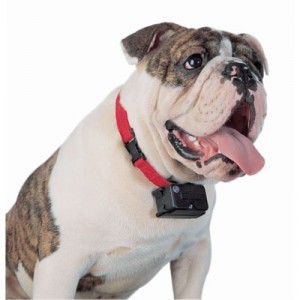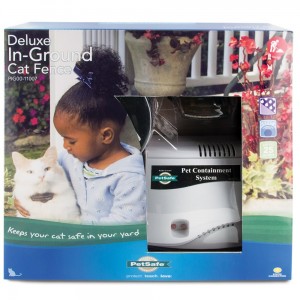Disclaimer: Da following iz a paid post and doz not necessarily reflect my opinion (if it did it would be written in my own kitteh voice). But please read through and let us know what you think. All da folks dat comment or share dis post will be enter in a giveaway of an Amazon.com $25 gift card.
The old saying “fighting like cats and dogs” is so popular because it’s often an accurate description of a multi-animal household. While it’s also common for cats and dogs to get along and coexist peacefully, sometimes measures must be taken to keep your pets separate. There are many ways this can be done, so let’s explore some of the options for maintaining “dog only” and “cat only” zones in your home and yard.
Temporary Solutions
Putting your dogs or cats in crates/cages while the others are roaming free works, but it should not be relied on permanently. Some people lock their dogs or cats in designated rooms, which works, but isn’t the ideal way for pets to live. Baby gates can also be employed in the home, but they tend to be bothersome obstacles for people, and they can be knocked down by determined pets. In the yard, dogs can remain on leashes/chains, but this is not safe to do on a daily basis or without supervision. While these methods may work in the short-term, it’s preferable to find a long-term solution to the problem of separating pets.
Electronic Fences
 An electronic dog fence can be an excellent tool for maintaining personal zones for your cats and dogs. In the yard, invisible fences can be used to establish boundaries for your dogs, preventing them from chasing cats who are free to roam outside as they please. A DIY electric dog fence allows you to create a custom zone for your dogs that encompasses as much or as little of your property as you desire. A wireless dog fence is even easier to set up and begin using. For both wireless and wired systems, your dog will wear an e-collar that emits a warning tone when they are approaching their boundaries. If they get too close, a mild static shock will deter them from crossing the perimeter line.
An electronic dog fence can be an excellent tool for maintaining personal zones for your cats and dogs. In the yard, invisible fences can be used to establish boundaries for your dogs, preventing them from chasing cats who are free to roam outside as they please. A DIY electric dog fence allows you to create a custom zone for your dogs that encompasses as much or as little of your property as you desire. A wireless dog fence is even easier to set up and begin using. For both wireless and wired systems, your dog will wear an e-collar that emits a warning tone when they are approaching their boundaries. If they get too close, a mild static shock will deter them from crossing the perimeter line.
There are also electronic fences for cats. Small e-collars with the mildest static shocks have been designed for cats, and these e-collars are compatible with several different types of invisible dog fences. With proper training, you can teach your cats to remain in their own designated zone away from your dogs. Even if separating your cats from dogs is not an issue, an electronic cat fence can be used to ensure your outdoor cats remain on your property. Oftentimes cats learn the invisible fence system and boundaries even quicker than dogs; although training can still take up to two weeks.
Indoor Pet Barriers
There are also pet barriers that are designed for use within the home. Electronic pet barriers are designed to fit within doorways and hallways without obstructing the path for humans. Your dogs or cats would wear e-collars to reinforce the boundaries they’d learn in training. This can make it easy to relegate your pets to certain sections of the home, without relying on crates, cages, leashes, or closed and locked doors. There are also other forms of indoor pet barriers, such as harmless-but-annoying deterrent sprays, some of which are motion-activated.
Choosing Containment Tools
 If you’re interested in purchasing tools for containing and separating your dogs and cats, be sure to do some diligent research on the many different products that are available. If you’re interested in an electric fence for dogs or cats, you’ll need to get a system that is adequate for the size of the area you want to enclose, as well as compatible e-collars that are appropriate for the size of your pets. For help navigating the many different choices that are on the market, dog electric fence reviews can be very useful. It’s also a good idea to peruse online reviews, blogs, and other forums in order to read more about the experiences of other cat and dogs owners who had the same separation needs and tried particular products.
If you’re interested in purchasing tools for containing and separating your dogs and cats, be sure to do some diligent research on the many different products that are available. If you’re interested in an electric fence for dogs or cats, you’ll need to get a system that is adequate for the size of the area you want to enclose, as well as compatible e-collars that are appropriate for the size of your pets. For help navigating the many different choices that are on the market, dog electric fence reviews can be very useful. It’s also a good idea to peruse online reviews, blogs, and other forums in order to read more about the experiences of other cat and dogs owners who had the same separation needs and tried particular products.
No matter how you choose to separate your cats and dogs, patience, compassion, and training are essential for maintaining the peace and harmony in your home. Over time, most cats and dogs will learn to respect each other’s personal space, and any problems that occur during the adjustment phase will dissipate. Sometimes, however, certain dogs and cats will be simply unable to come to a mutual understanding. If prolonged aggression or territorial urges are threatening the safety of any of your animals, it may be necessary to consider rehoming one or more of the instigating parties. While it’s never easy to make that decision, the safety, well-being, and happiness of all of your animals will always be your priority.
Published in partnership with www.dogfencediy.com. We also encourage questions to help you understand if this type of dog fence is for you. Commenters and those who share the post in social media qualify for a drawing of a $25 Amazon gift card!
For the giveaway please enter by posting a comment to this post and/or sharing on fb or Twitter. Fill out the Rafflecopter form below so we can keep track of your entries (each share/comment is 1 entry). Giveaway ends 7/12/15. Good luck and thank you. (winner must contact me within 24 hours to get prize)
